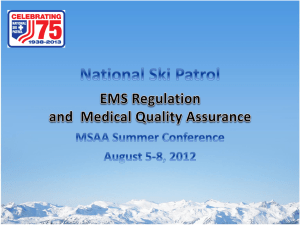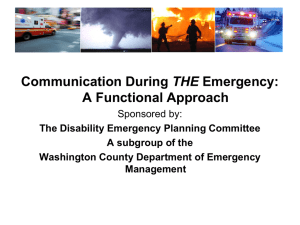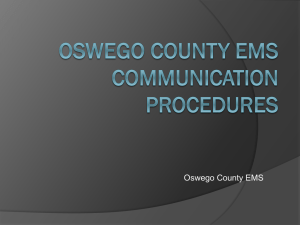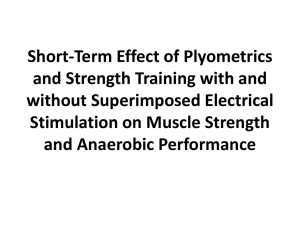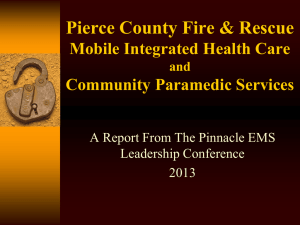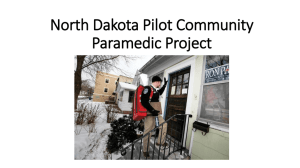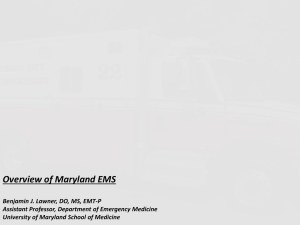Best Practices in EMS 2011.ppt
advertisement
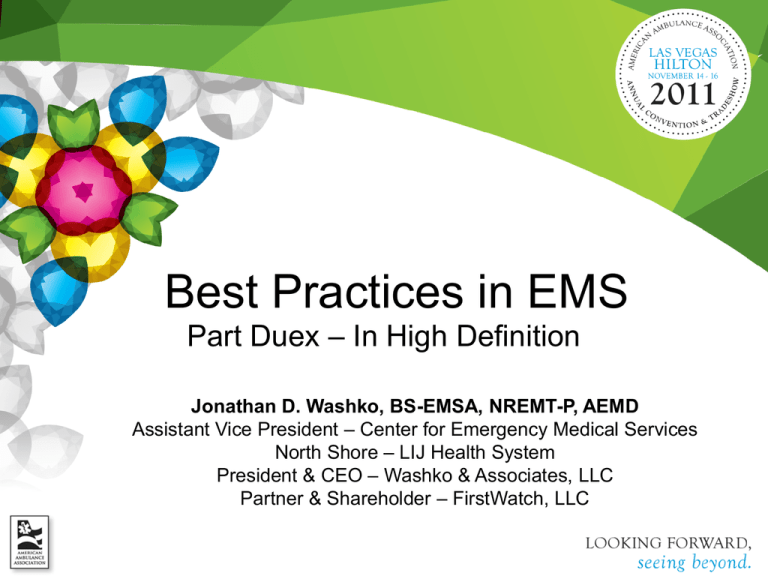
Best Practices in EMS Part Duex – In High Definition Jonathan D. Washko, BS-EMSA, NREMT-P, AEMD Assistant Vice President – Center for Emergency Medical Services North Shore – LIJ Health System President & CEO – Washko & Associates, LLC Partner & Shareholder – FirstWatch, LLC About Us… • Located in NYC / Long Island Region • Highly competitive marketplace • 600+ Employees and growing • 100+ Vehicles and growing • 100,000+ Annual call volume and growing • $40M+ Annual budget About Us… • • • • • 9-1-1 Programs (FDNY & Municipal) Inter-facility / CCT-SCT / Private Emergency Training / Command & Control / Billing / PI Multiple deployment centers throughout region Defining a new category of EMS system design – “Healthcare System” Based EMS Agency – On the bleeding edge of “Systems” of care based healthcare under ACA / HCR – Coordinated network management of patients – Have a seat at the table (untraditional) About Us… • Our “Cradle to Grave” Healthcare System – – – – – – – – 4 Tertiary Hospitals 11 Community Hospitals 1000’s Doctors / Clinics Nursing Homes / Rehabs / Home Care / Hospice Internal and External Pharmacies 42,000+ Employees Revenues of $6B+ 2nd Largest Not for Profit Secular Health System in the United States – Partially Integrated working towards complete integration Best Practices in EMS Part Un (The Original) • In Best Practices Part I (In case you missed it) – Low Def discussion on: Operations, Deployment, EMS System Design, Fleet Maintenance, Training, Quality Improvement, Billing, Communications, Technology, Administration, Human Resources – Part I presentation available at • http://washkoassoc.com/knowledgebase.aspx Best Practices in EMS Part Duex – In HD • What is a Best Practice • Why Does EMS Need Best Practices • Best Practices – Shared – Smaller number but in greater detail – Success Common Denominators • Emerging & Future Best Practices – Acknowledge ACA / HCR – Matches our theme • Share Your Best Practices What is a Best Practice • A Best Practice is the belief that there is a technique, method, process, activity, incentive or reward that is more effective at delivering a particular outcome than any other technique, method, process, etc. The idea is that with proper processes, checks, and testing, a desired outcome can be delivered with fewer problems and unforeseen complications. Best practices can also be defined as the most efficient (least amount of effort) and effective (best results) way of accomplishing a task, based on repeatable procedures that have proven themselves over time for large numbers of people. Why Does EMS Need Best Practices? • Service delivery model variations / inconsistencies • Lack of commonly accepted operational standards (like NFPA for Fire Service) • Mix of public / private / government ownership • Mix of for profit / non-profit models Why Does EMS Need Best Practices? • Lack of standardized advanced managerial education platform • Industry has attempted to bridge educational gap with limited success • Success lies in sharing some clinical & billing best practices but not operational ones Best Practices – Shared • Successful EMS Agency Common Denominators – Customer Service – Employee Well-being • Safety & Risk Management • Human Resources • Information Technology (my favorite and always something new to talk about) Successful EMS Agency Common Denominators Successful EMS Agency Common Denominators • Leverage many of the pragmatic / tangible programs and methodologies discussed in Best Practices - Part One • Also embrace the concept of the EMS Success Triad – Whether you call it this or not EMS Success Triad • Balancing of – Patient Care • Clinical sophistication • ***Customer Service – Employee Well-being • Compensation • ***Health / safety / welfare – Financial Stability • Properly designed service delivery system • Revenue maximization Customer Service • What do our customers truly care about? – On time performance / timeliness – Service reliability & consistency – Look & feel of providers – Professionalism of interaction (bedside manner) – Ride comfort in back of ambulance – Ambulance cleanliness and organization Customer Service • But you forgot clinical… – Remember most patients assume they will receive good clinical care – Have no other frame of reference other than customer service related experiences – We hear about clinical issues when… • We do something really - really good • We do something really - really bad Customer Service • Common denominators of successful EMS agencies include: – Spend more money on uniform quality and durability than others – Pay attention to details on ambulance layout, look, restocking, cleanliness and maintenance – Provide superior customer service training and organizational culture / focus – Have solid clinical & training programs – Seek external feedback, validation & benchmarking • Accreditation & Surveys Employee Well-being • Common denominators of successful EMS agencies include: – Truly care about what happens with their people – Embrace, understand and leverage generational differences – Have consistent, intentional contact with management • Flow engineering of building • Ride-a-longs • Team meetings / interactions – Employee input is valued, acted upon, compensated for, embraced and sought after Employee Well-being • Common denominators of successful EMS agencies include: – Supplement employee shortcomings • • • • Personal financial management training Coaching / mentoring programs Education beyond clinical opportunities Solid EAP programs / Psychological support – Performance improvement • Tie performance to shift bid weighting • Pay for objectively based performance Employee Well-being • Common denominators of successful EMS agencies include: – Recognition / reward programs • • • • Employee involvement Public recognition on jobs well done Sharing of letters from patients and family Shameless promotion of good stories and outcomes – Fairly and consistently applied rules, regulations and consequences • No good ole boy syndrome Employee Well-being • Common denominators of successful EMS agencies include: – Workload management and load balancing • UHU monitoring • Real-time equal distribution of NET – UHU “sweet spot” balance governance • Once found, stay in the zone – EOS late call mitigation strategies • Actively monitor, RCA and mitigate Employee Well-being • Common denominators of successful EMS agencies include: – Vehicle cab design • • • • • Acknowledge employee time spent in vehicle Crew comfort engineered into cab design Safety important consideration Ergonomics Creature comfort needs addressed & met – DVD / iPod / AC-DC Power / Internet Access • Properly maintained seating / arm rests • Cup holders Employee Well-being • Common denominators of successful EMS agencies include: – Flexible schedules that minimize days worked • 3 day work weeks • Many in EMS have “B” or secondary jobs • Consider work from home programs with A/R staff – Routine employee appreciation “events” • Cook-outs / socials / holidays • Gift cards (Food, Drinks, iTunes) Employee Well-being • Common denominators of successful EMS agencies include: – Family involvement & recognition of needs • • • • Active military family support Invitation to participate in company events Flexibility in dealing with family emergencies Acknowledgement of life-altering events – Births / deaths / marriages / divorces Employee Well-being • Common denominators of successful EMS agencies include: – Employee Health • Tie financial rewards to entice healthier lifestyles, risk assessments and preventative treatments – Per pay period benefit rebate for anti-smoking, annual physical, flu shots (it works) • Weight mitigation – Biggest looser / weight watchers – Support / tools / education Employee Well-being • Biggest challenge with no easy solution… – Communications with staff in a 24x7 geographically dispersed environment • Email communication not accepted by younger generation • Social media has some potential to bridge gap • “AIMS” may be a piece of the solution (more on this later) • Multi-media / multi-sourced approaches – ??? results • Always on lookout for “Best Practices” Safety & Risk Management / Mitigation Safety & Risk Management / Mitigation • Embracing healthcare based safety systems in EMS – National Center for Patient Safety • Prevention and mitigation strategies – TeamSTEPPS • Aviation based Crew Resource Management (CRM) but designed for Healthcare • Developed by Dept. of HHS Safety & Risk Management / Mitigation • Situation: – On routine inter-facility transport of a voluntary psychiatric commitment patient, EMS crew and bystanders (who stopped to assist the crew) were viciously assaulted by the patient – Attack was completely unprovoked and unanticipated – Paramedic was beaten with ePCR Panasonic Tough Book and patient fists – Patient then stole a car of off-duty police officer and was later apprehended after crashing vehicle in NYC How would EMS traditionally react to a situation like this? • Investigate – Extremely low probability situation – No fault / not predictable • Reaction – Possibly provide additional training – Policy / procedural changes – Ignore and do nothing but mourn situation How Healthcare Would Respond • Initiate an independent root cause analysis (RCA) of the situation • Entire “system” of care involved in analysis from start to finish • Cause & Effect determined • Look how best to fix • Make necessary changes to prevent recurrence • Measure outcomes How Healthcare Would Respond RCA Cause & Effect Our Epiphany • Most psychiatric patients in hospitals are placed into access controlled rooms, that are “sterile” of medical equipment, cords, etc. of which the patient could hurt self or others • But when transporting, we place these patients in a cage, with limited exits, with weapons (medical equipment), with our employees in a magic vehicle called an ambulance and believe nothing will ever happen How a Healthcare System based EMS Agency did respond… • • • • De-escalation training Self defense training TeamSTEPPS training New policy & procedure How a Healthcare System based EMS Agency did respond • Pre-transport “huddle” by sending transport clinicians and EMS staff • Use of standardized risk assessment scripts / tools at intake & bedside How a Healthcare System based EMS Agency did respond… How would EMS traditionally react to a situation like this? Recurrent patient drops due to stretcher hook not catching when removing patient from back of ambulance How would EMS traditionally react to a situation like this? • Investigate – At fault / predictable situation – Moderate risk / frequency • Reaction – Check equipment (stretcher height) – Retraining (provider fault) – Hope it doesn’t happen again How Healthcare Would Respond How would EMS traditionally react to a situation like this? • Investigate – At fault / predictable situation – Moderate risk / frequency • Reaction – Check equipment – Retraining (provider fault) – Hope it doesn’t happen again How a Healthcare System based EMS Agency did respond… Takeaway from these examples • I learned something new from another part of healthcare • Best practices can be found outside the industry that are applicable to EMS • Engineering solutions are stronger than all of the traditional responses to risk events that I have used in the past combined Human Resources Human Resources • Candidate selection with psychological screening – Detect positive and negative behaviors – Customer service predisposition – Risky behavior predisposition – Skills / ability confirmation • AVESTA / Crit-i-call • Lecture on this topic later by SeniorCare on Wednesday morning Human Resources • Reworking of traditional EMS Orientation / FTO Programs – Traditional 1 - 2 weeks of class orientation – Long FTO Ride-a-long – Employee released by FTO to field • Problems with this approach – Employees don’t receive consistent didactic content – Subjective review of field “readiness” based on variably applied criteria – Inconsistent results / unreliable throughput Human Resources • Training Academy Approach – FD/LE/Military based concept – Enough classroom time to complete and confirm total didactic competencies (3-4 weeks) – Use of simulation to teach and confirm psychomotor skillsets – Field time for reality based verification of didactic and psychomotor skills competencies Human Resources • Advanced Headcount Management – Predictive gain / loss analysis process – Inclusion of PTO / LOA / Workers Comp Loss – PRN / PT weighting in calculations – Routine meeting to discuss changes / needs – Hire ahead of the anticipated loss curve Advanced Headcount Management Example Human Resources • Take-a-ways from these programs – Traditional EMS orientation models are antiquated and need refreshing – Better input process controls yield better output quality – Quality of personality traits can be scientifically quantified vs. subjectively guessed at – Skills and abilities can be objectively tested and benchmarked against a standard – Proactive headcount management improves service reliability, decreases domino effects of loss of staff Human Resources • Program Benefits – Reduce turnover – Reduce hiring & training expenses – Consistency in process / education output – Improve educational quality and assured content delivery – Reliability / predictability in throughput timelines – Reduce / eliminate staffing related problems Technology Technology • Productivity improvement – Rescue Time • Real-time monitoring and feedback systems • Silently watch and time all computer interactions • Categorize activities into blocks of productive and unproductive time • Asks what you did when away • Provides feedback through reports, a scoring system, benchmark reporting and reward badges Technology • Productivity improvement success suite – Get Things Done (GTD) Methodology • David Allen – Omnifocus (Mac / iPad / iPhone) • GTD Management System – Evernote • Your life long searchable on-line brain / memory – 37 Signals Basecamp / Highrise / Campfire • Collaborative project management, CRM & communication system Technology • Administrative Information Management Systems (A.I.M.S.) – What they are not • CAD, Billing, ePCR – What they are • Pretty much everything else (convergence) • Commonly stove-piped systems brought together under one roof • Leverage sharing of information databases • Next cloud based technology to capture EMS $$$ Technology • A.I.M.S. – Schedule management system • Designed to meet EMS scheduling complexity • Typically integrate into most payroll systems – All aspects of employee information management • Certification, Human Resources, Commendations – All aspects of asset / inventory management • Fleet, supplies, DME Technology • A.I.M.S. – All aspects of information management • Incident reporting, Accident reports, Document archive – Content delivery and management • Training, CME, EE Communication, Memos, Announcements – Clinical Improvement information management • Clinical reviews, feedback tracking, remediation – CAD / ePCR integration Technology • A.I.M.S. – Workflow driven (very important) • Ensure follow-up and feedback loop closure • “Check list” based approvals – Most are customizable to agency needs • Can add / delete what you want to use or not • Customize nomenclature, workflows, data elements A.I.M.S. • Upside – Improve productivity, communication & information sharing across the enterprise – Available 24x7x365 – Eliminates rework and redundancy inefficiencies – Relatively inexpensive – One password / URL ! • Downside – Emerging / new (unforeseen consequences) – Single point of failure / loss – Information security / sensitivity (most have customizable access levels) A.I.M.S. • Examples – 9th Brain, eCore, EMS Toolkit, Sharepoint • Driving Industry trend – Single use cloud-based systems being driven to this model or will merge with others to compete – Benefits us as consumers as we get more for our money if the company adds features without additional expense Emerging & Future Best Practices • Benchmarking • ACA / HCR / ACO • New Emerging EMS Markets Benchmarking • Existing Commercial Systems – Customer service • EMS Survey Team • Existing Grass Root Based – Operational • Zoll • CAEMSS – Clinical • AHA, STEMI, Stroke – Financial • Zoll / CAEMSS / AAA Benchmarking • On the Horizon – Industry based benchmarking defined by professional association consensus using independent management mechanisms to collect, maintain and report on data – Commonly accepted definitions, anonymity, data integrity and data usefulness key hallmarks to success – AAA is taking lead in driving this collaborative effort as a benefit to its members • CAAS / CAEMSS / NREMT / Others ACA / HCR / ACO • R/Evolutionary changes to reimbursement & patient care • If enacted could change our entire business model (innovators) • Will drive mergers & consolidation of EMS by healthcare systems and others • EMS not currently seen as even a blip on the HCR radar…however… ACA / HCR / ACO • So why are VC companies pouring dollars into the purchasing of EMS firms? – Understand the value in undervalued value – Just because the Feds have missed the boat on what EMS can bring to the HCR table doesn’t mean private industry will – Eventually healthcare & reimbursement companies will understand the value of EMS and who will control most of it then? – Current system is not sustainable Emerging Undervalued EMS Markets / Capabilities • Gate keeping – Financial – Network • Population health • Network management – In / within / out of • Ambulatory / post acute care follow up • Health systems integration Emerging Undervalued EMS Markets / Capabilities • Some of these concepts have been around for a long time – AAA has had Expanded Scope guidance documents since 1990’s – European health models have leveraged these strategies for quite some time and we can learn a lot from them • Economics have not been aligned to perpetuate these programs (mostly been altruistic in nature) – F.F.S. models got us where we are today – Accountability based savings models coming Emerging Undervalued EMS Markets / Capabilities • HCR fundamentally resets economic conditions of healthcare reimbursement making EMS capabilities highly valuable for downstream healthcare savings – ACOs one possibility / mechanism – Payment bundling into hands of a “new consumer” – the healthcare system • Come to our Wednesday afternoon session on the ABC’s of ACO’s to learn more… Share Your Best Practices… Thank You! Jonathan D. Washko, BS-EMSA, NREMT-P, AEMD North Shore – LIJ Center for EMS 15 Burke Ln, Syosset, NY 11791 O: 516-719-5042 | C: 516-408-8063 | jwashko@nshs.edu
